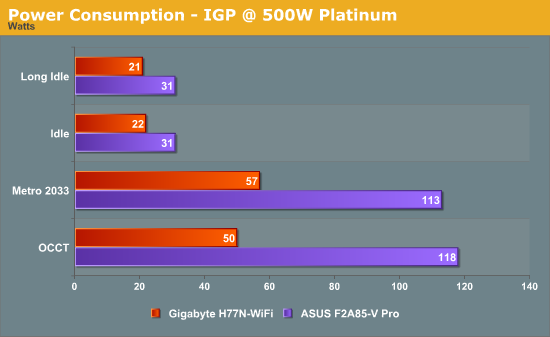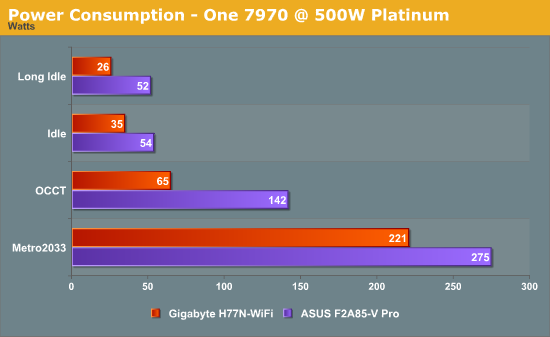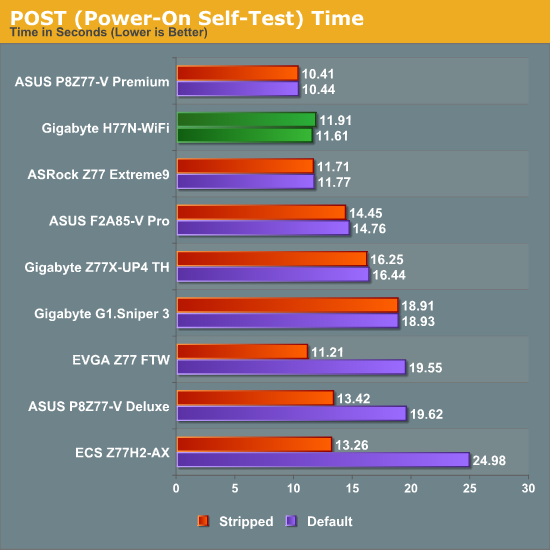Gigabyte H77N-WiFi Review – First Look at Ivy Bridge with mITX
by Ian Cutress on November 6, 2012 12:00 PM EST- Posted in
- Motherboards
- Gigabyte
- H77
- mITX
Many thanks to...
We must thank the following companies for kindly donating hardware for our test bed:
OCZ for donating the SSDs
Micron for donating our SATA testing SSD
G.Skill for donating our memory kits
ASUS for donating AMD GPUs and some IO Testing kit
ECS for donating NVIDIA GPUs
Gigabyte for donating the i3-3225 used for comparison
Rosewill for donating the Power Supply
Test Setup
| Test Bed | |
| Processor |
Intel Core i3-3225 @ 3.3 GHz 2 Cores, 4 Threads |
| Motherboards | Gigabyte H77N-WiFi |
| Cooling | Thermalright TRUE Copper |
| Power Supply | Rosewill SilentNight 500W |
| Memory | GSkill RipjawsX 2x4 GB DDR3-1600 9-9-9 |
| Memory Settings | XMP |
| Video Cards |
ASUS HD7970 3GB ECS GTX 580 1536MB |
| Video Drivers |
Catalyst 12.3 NVIDIA Drivers 296.10 WHQL |
| Hard Drive | OCZ Vertex 3 240GB |
| Optical Drive | LG GH22NS50 |
| Case | Open Test Bed - CoolerMaster Lab V1.0 |
| Operating System | Windows 7 64-bit |
| SATA Testing | OCZ Vertex 3 128GB |
| USB 2/3 Testing | OCZ Vertex 3 240GB with SATA->USB Adaptor |
Power Consumption
Power consumption was tested on the system as a whole with a wall meter connected to a Rosewill 500W 80PLUS Platinum SilentNight power supply. As I am in the UK on a 230-240 V supply, leads to ~75% efficiency at low loads, and 90%+ efficiency between 20% and 100% loading. This method of power reading allows us to compare the power management of the UEFI and the board to supply components with power under load, and includes typical PSU losses due to efficiency. These are the real world values that consumers may expect from a typical system (minus the monitor) using this motherboard.


Using the i3-3225 processor gives an amazing idle power usage – 21 W on IGP. Even with a 500W Platinum power supply, 21 W is still on the very low end of efficiency. I wouldn’t be surprised if the actual draw was more like 14-16 W.
POST Time
Different motherboards have different POST sequences before an operating system is initialized. A lot of this is dependent on the board itself, and POST boot time is determined by the controllers on board (and the sequence of how those extras are organized). As part of our testing, we are now going to look at the POST Boot Time - this is the time from pressing the ON button on the computer to when Windows starts loading. (We discount Windows loading as it is highly variable given Windows specific features.) These results are subject to human error, so please allow +/- 1 second in these results.

With the launch of Windows 8, most of the motherboard manufacturers are scrambling to update their BIOSes to take advantage of some of the Windows 8 features. This has resulted in reduced boot times – manufacturers that were taking 18 seconds to POST are down to 12 or below. I have been quoted that with the right combination of hardware and BIOS options, some setups can be in the operating system in 2-4 seconds. Nevertheless it also has a knock on affect for other operating systems – the Gigabyte H77N-WiFi is able to boot in a highly respectable 11.61 seconds with a 7970 attached.










52 Comments
View All Comments
457R4LDR34DKN07 - Tuesday, November 6, 2012 - link
Zotac Z77 A-E is vastly superior. It is the only mITX Z77 that has a mSATA. You could even remove the wifi/bt module and put in a mpci-e tv tuner and use the antenna.K-thiraband-com - Tuesday, November 6, 2012 - link
The ASRock Z77E-ITX also has mSATA.http://www.newegg.com/Product/Product.aspx?Item=N8...
RicardoNeuer - Thursday, November 8, 2012 - link
just as Eddie implied I'm startled that some one can earn $9332 in a few weeks on the internet. have you seen this(Click on menu Home more information)http://goo.gl/lbKGT
cjs150 - Tuesday, November 6, 2012 - link
I have the ASrock z77 E-ITX which is a lovely mini itx board and has a MSata on the back. Admittedly only SATA2 (like all MSata sockets at moment).Go for the samsung green low profile memory (fantastic overclocking potential) and there is no need to worry about CPU coolers interfering with memory heat spreaders.
What I would really like is for MB makers to put the ATX socket at right angles to the board, it would make cable management much easier, and that is always a problem in Mini ITX cases.
The Gigabyte board is a lot cheaper than my ASrock board, but I would not change it.
philipma1957 - Tuesday, November 6, 2012 - link
there are 3 itx mobos and I own 2 of them I have the truly great ASrockz77 E-ITX with a msata under the board I have a crucial 256gb in it.I also own an intel BoxDH77DF
http://www.newegg.com/Product/Product.aspx?Item=N8...
Which allows this:
1 x PCI Express Full-/Half-Mini Card slot with support for mSATA .
my build has a crucial msata in it also the 256gb size.
frankly I won't buy anyboard that does not have a msata option/
looking at this board you may be able to run a msata instead of the wifi.
frankly if you go itx msata is a godsend for space and wire management
PEJUman - Tuesday, November 6, 2012 - link
I have the asus H77 ITX, with 3770 + 2 x 2.5" SSDs + 2 x 3.5" Velociraptors with icepack. all inside a antec ISK 65, which is powered with 150W dell power brick to get around the 65 limit.I did have to modify the ISK removable frame brace to mount the 2 x 3.5" velociraptors, but there is enough airflow with 2 x 80mm + some clever ducting using a thin piece of flexible plastic to keep everything cool under load (prime + crystal diskmark): 85 C CPU & 45 C on raptors.
it's it very tight, but that is half of the fun on building PCs;
where is the challange on building mini HTPC with mSATA hehehe =P.
The reason I picked the asus board is for the 6 SATAs, when it becomes obsolete, it would serve a a power efficient, cost efective file server.
Samus - Wednesday, November 7, 2012 - link
I think most people would prefer an Asus, Gigabyte, Asrock, etc over a Zotac. The only reason to ever buy Zotac products in the past was for the nVidia ION options they provided when nobody else did. These days, Zotac is less innovative and quality/support have always been lacking, so why would you even consider them when there are higher quality, similarly priced competing products?rafa333 - Friday, December 7, 2012 - link
you are sow dirty assabrogan - Friday, December 7, 2012 - link
The Zotac board uses thin steel "threads" to mount the wifi antennas. This is a very poor design. After receiving one already broken in the box, and after examining the proper way to do it (the gigabyte uses a folded plate), I won't purchase a Zotac again.GoodBytes - Tuesday, November 6, 2012 - link
On the POST performance table, I don't understand whats the difference between stripped and default. Can someone please explain it to me? I can't seam to find any info on this on the review. Thanks.